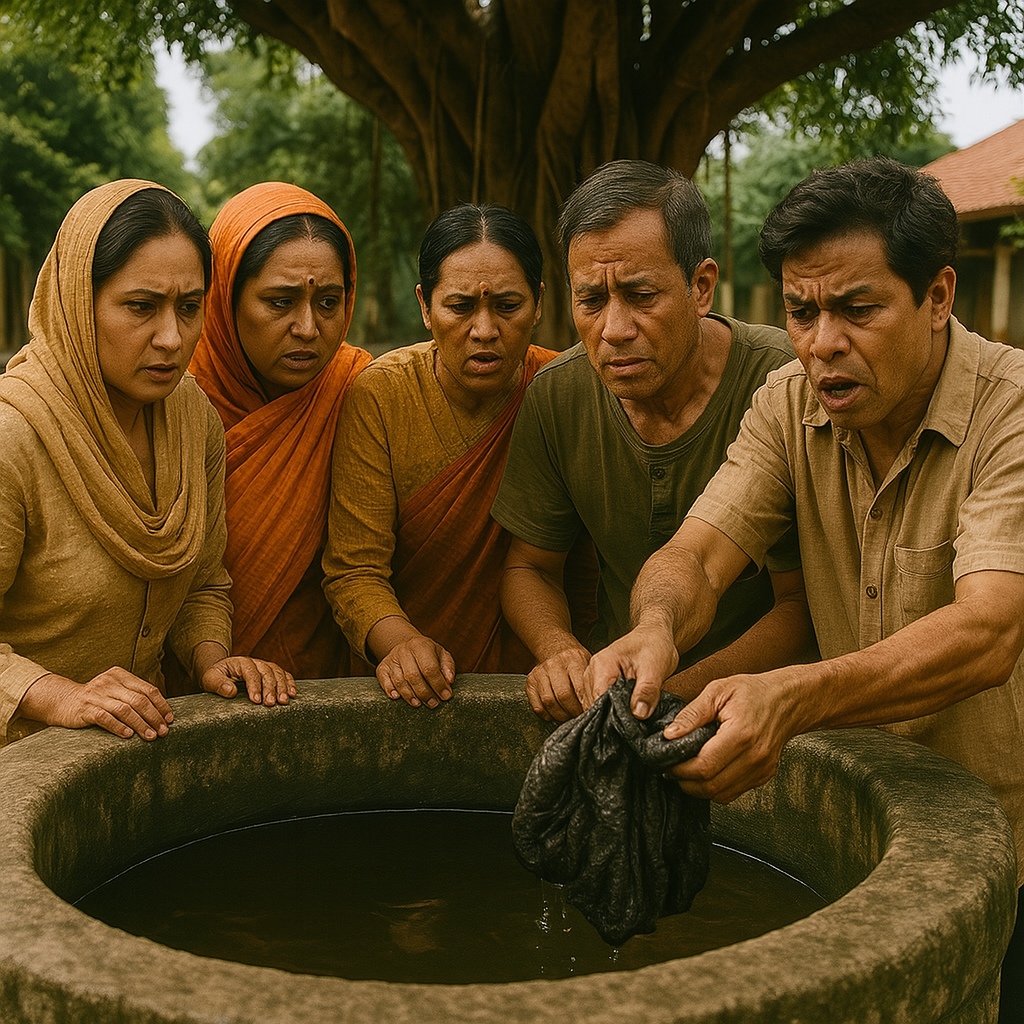The village of Chandipur was usually peaceful, serene year-round with its ancient banyan tree, communal well, and temple courtyard. But that morning, the entire village was in an uproar when a faint wailing sound echoed from the ancient well at the edge of the village.

The cries, mixed with the cold mist, carried far through the narrow lanes. Old Mrs. Kamla, who sold idlis, heard it first. Her face went pale as she shouted:
“Oh my God, a child has fallen into the well!”
In just a moment, the villagers gathered, crowding around.
The village headman, Sarpanch Singh, quickly directed:
“Quickly, get a bucket, get a rope, save them!”
Several strong young men hastily tied a rope ladder and lowered it. One person swam down into the icy well, fumbling to retrieve a… soggy cloth bundle.
As soon as the bundle was brought to the bank, the crying immediately stopped.
Everyone held their breath. Sarpanch Singh’s hands trembled as he opened the cloth bundle. Inside… there was no person at all. It turned out to be… a dilapidated old doll, its eyes wide and lifeless, and inside its belly was a small, broken music box, emitting a steady “oe oe” sound like a child’s cry.
The entire village was stunned. No one spoke a word. Horror mixed with disappointment. So, there was no child that had fallen into the well.
Sarpanch Singh bent down and picked up the doll. It was soaking wet, covered in mud. When he gently squeezed its belly, the faint “oe oe” sound came out weakly, then stopped completely. Perhaps the water had completely ruined the mechanism inside.
The villagers began to murmur among themselves.
“Who could be so heartless as to throw something like this into the village well?” “Or did someone want to scare the villagers?” “It looks so creepy!”
As everyone was confused, an old man with white hair, who lived closest to the well, suddenly spoke up, his voice trembling:
“This… this belongs to Little Radha, Mr. Das’s daughter.”
Mr. Das was a widower with a young daughter named Radha. Radha had a serious illness, was frail since childhood, and treasured an old doll. Her father had repaired this doll many times. Three days ago, Radha had passed away. Mr. Das, overwhelmed by grief, had lost all interest in everything, often neglecting things.
The old man recounted that last night he saw Mr. Das quietly going to the well, holding something. He thought Mr. Das was drawing water at night, so he didn’t pay much attention.
Hearing this, everyone suddenly understood. The horror of a child falling into the well dissipated, replaced by sorrow and sympathy. Perhaps Mr. Das, in his overwhelming grief over his daughter’s death, didn’t want to see the memento that reminded him of her, or wanted to leave the doll where his daughter had loved to play (Radha often played near the village well), so he had thrown it in. The “oe oe” sound might have been due to the music mechanism malfunctioning when it fell into the water, or because the doll was compressed upon impact.
The entire village looked at each other. No one felt scared anymore, only deep empathy. They quietly dispersed, leaving Sarpanch Singh with the soaking wet doll.
That afternoon, Sarpanch Singh, along with a few other elders from the village, went to Mr. Das’s house. The house was silent, the door slightly ajar. Mr. Das sat huddled in a corner, his eyes vacant. Sarpanch Singh placed the cleaned doll on the table.
Mr. Das saw the doll, and his eyes welled up with tears. He said nothing, just gently picked up the doll, stroking its tangled hair. Tears silently streamed down his aged face.
From that day on, the villagers visited Mr. Das’s house more often. They brought food, helped him clean his house, and sat with him, sharing tea and stories. The village well remained the village well, but from the story of the doll that night, it had become a symbol of loss, and also of warm, sharing community spirit.
News
At 61, I remarried my first love. On our wedding night, as I took off my wife’s traditional dress, I was startled and pained to see…
I am Arjun, 61 years old this year. My first wife passed away 8 years ago from a serious illness….
30 minutes later, my sister was stunned when our family called with news:
My younger brother, the youngest in our family, is only 37. Unmarried and without children, he just bought a piece…
Thinking my stay-at-home wife was a spendthrift, I pretended to go bankrupt to teach her a lesson. To my surprise, that evening she brought dinner to the table and made an announcement that sent a chill down my spine…
I’m a businessman, and my wife, Priya, stays at home to take care of our two young children. Every month,…
In the middle of the night, a son-in-law called his father-in-law and told him to take his daughter back and “re-educate” her. 15 minutes later, the father-in-law arrived with something that left his son-in-law speechless…
It was nearly midnight, with a light drizzle falling outside. In the cold living room, the atmosphere was as tense…
On the day I found out I was pregnant, his mother brought me 20 lakh rupees and told me to break up. I took the money and left without a word. Eight months later, I fainted in the delivery room when I saw…
I never thought that the doctor who delivered my baby would be my ex-boyfriend, Rohan. The child in my womb,…
A poor young woman gives shelter to a man and his four children on a rainy night — what he does next leaves her completely shocked and stunned…
That night, the rain poured down relentlessly. A biting cold wind whipped violently against the small, dilapidated house at the…
End of content
No more pages to load












